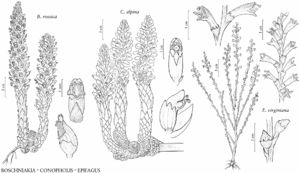Conopholis
Orobanches Gen. Diask., 78. 1825.
| Taxon | Illustrator ⠉ | |
|---|---|---|
 | Boschniakia rossica Conopholis alpina Epifagus virginiana | John Myers John Myers John Myers |
Herbs, perennial; achlorophyllous, holoparasitic, with perennial, tuberlike underground vegetative structure attached to host root, dark-brown or black, with a sclerenchymatous, knobby surface, roots absent. Stems erect, yellow, brown, or black, fleshy, glabrous. Leaves cauline, spiral, tightly imbricate; petiole absent; blade stiffly chartaceous, margins entire or minutely erose or ciliate. Inflorescences terminal, compact racemes; bracts present. Pedicels present; bracteoles present, sometimes absent. Flowers: sepals 2, 4, or 5, calyx bilaterally symmetric, tubular, divided abaxially, not divided adaxially, lobes lanceolate; petals 5, corolla yellow, strongly bilabiate, tubular, arching forward, abaxial lobes [1–] 3, adaxial 2, adaxial lip notched; stamens 4, didynamous, exserted, filaments glabrous or hairy at base; staminode 0; ovary 1-locular, placentation parietal; stigma disciform-crateriform or 2–4-lobed. Capsules: indehiscent. Seeds 300–600, glossy tan, brown, or black, irregularly ellipsoid or angled, wings absent.
Distribution
sw, e North America, Mexico, Central America
Discussion
Species 3 (2 in the flora).
Five species have been described in the genus; most authors accept Conopholis as including only from one to three species (R. R. Haynes 1971; A. G. Rodrigues et al. 2011, 2013). All taxa in the genus are strikingly similar morphologically. Differences in scale leaves, floral bracts, flowers, vestiture, and plant size have been used to separate species and varieties; the variability of these characters within taxa occasionally exceeds between-taxon differences. There is considerable overlap in any character set used to separate taxa. J. W. Thieret (1971) suggested that all taxa could be considered conspecific. Molecular and morphological studies by Rodrigues et al. (2011, 2013) provided strong evidence that three species should be recognized. The third taxon, C. panamensis Woodson, is known only from Central America. Hosts are all members of Quercus (Fagaceae).
Conopholis fruits develop a woody texture at maturity. Although members of the family are generally stated to produce capsular fruits, those of Conopholis generally remain indehiscent until degraded by either physical abrasion or invasion by predatory insects, such as ants. Seed dispersal tends to be of two types: short-range dispersal by the action of gravity, wind, and/or water following the breach of the wall; and longer-range dispersal following ingestion of the plants by various mammals.
Selected References
Lower Taxa
Key
| 1 | Bracts glabrous, lanceolate, mostly concealing calyces, margins entire or minutely erose, not ciliate; leaves glabrous or minutely hairy along margins, triangular to broadly lanceolate; calyces 3–8 mm, lobe apices acute; corollas 8–14 mm; anthers glabrous. | Conopholis americana |
| 1 | Bracts glandular-pubescent, narrowly lanceolate, mostly not concealing calyces, margins entire, glandular-ciliate; leaves mostly glandular-pubescent, triangular to narrowly lanceolate; calyces 6–9 mm, lobe apices obtuse; corollas 14–20 mm; anthers sparsely pilose or glabrous. | Conopholis alpina |